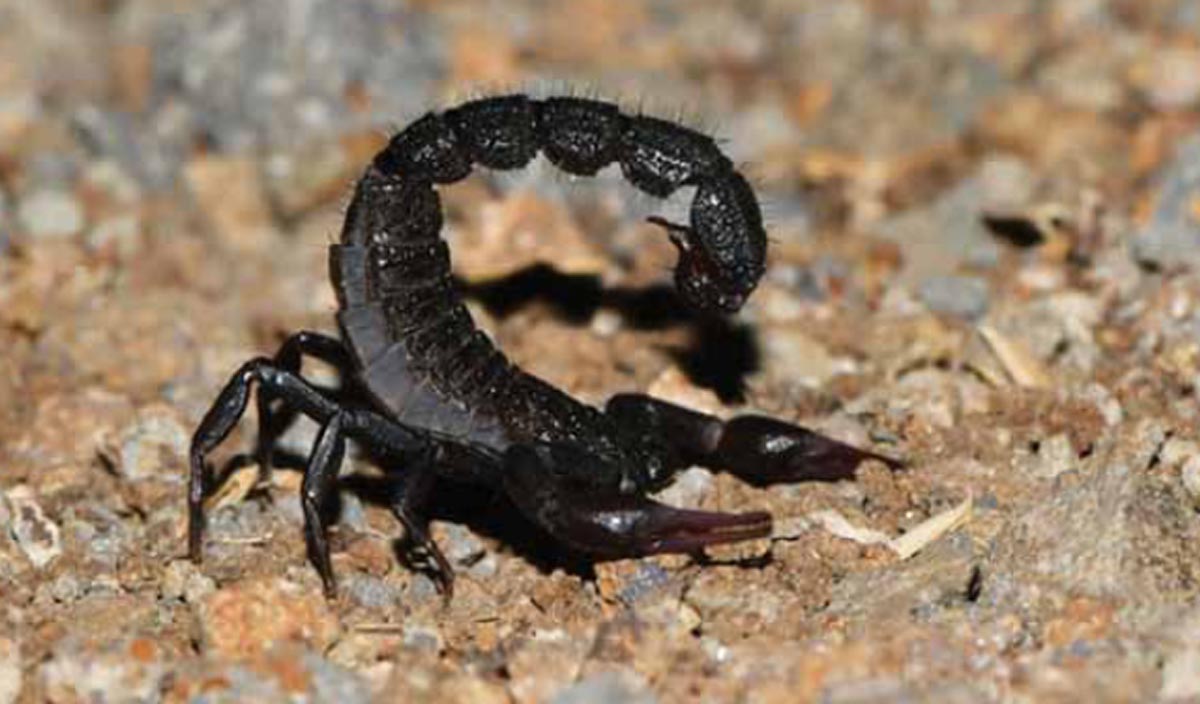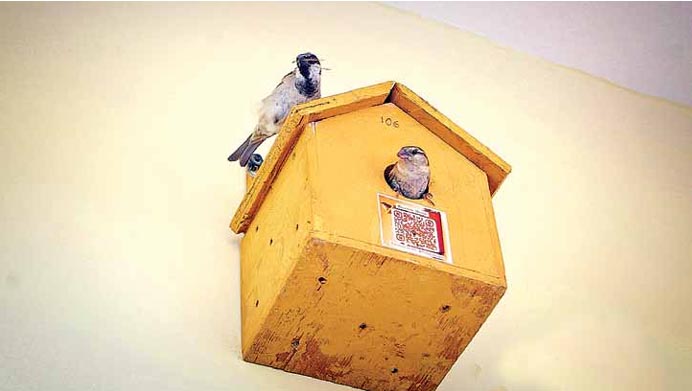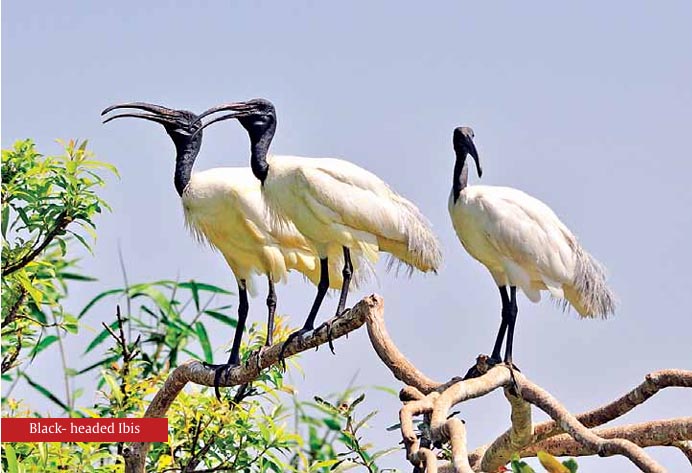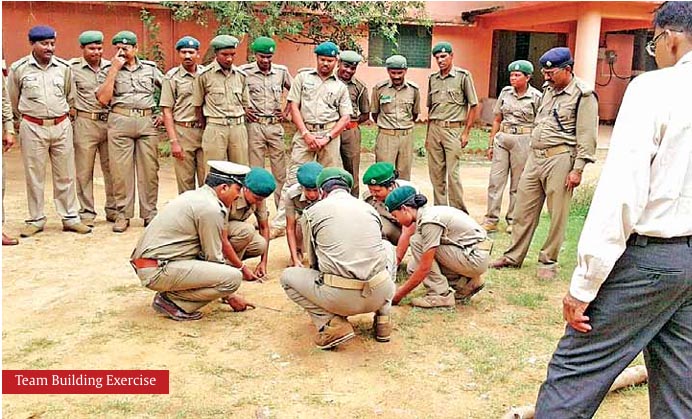
‘SWOT’ analysis of a leopard rescue operation
By Manish Singh, IFS and Rakesh Kumar Singh
Leopard rescue operations are one of the most frequent rescue operations that wildlife experts often have to carry out in the vicinity of human populations. But as difficult and risky this work is, it is also necessary to have technical knowledge in it. After doing SWOT analysis of one such leopard rescue operation, it was found that while on one hand, the experience of the rescue team leader coupled with quick decisionmaking was the biggest strength, on the other hand, the lack of experience of the supporting staff in leopard rescue, the loss of precious time due to the rescue team being in another nearby city and difficulty in management due to the presence of excessive crowd and noise were found to be the challenges as well as weaknesses of this operation. Despite not being in a Wildlife Division, this operation was carried out by the staff of the Social Forestry Division in a limited time with less resources. The immediate movement of the team to the place overnight to release the leopard in its natural habitat offered the biggest learning. Apart from that, in a situation where the crowd was making a lot of noise, the biggest opportunity was immobilizing any wild animal by using only the upper limit of immobilizing drugs. Few of the staff members became over-enthusiastic due to inexperience; The crowd was making excessive noise; The rescue team coming from another city took time to reach the rescue place due to excessive traffic congestion; These factors were found to be the threats in this study. Finally, taking out the caged wild animal from the unruly mob to a safe place was found to be a huge challenge.
coexist with human populations and have developed the ability to live near humans for many years without any human-wildlife conflict. But sometimes, incidents of human-wildlife conflict occur due to mistaken identity or accidentally. Thus human-wildlife conflict arises in some form or the other. Gangetic plains and adjacent Shivalik hills of Tarai region of India are among the best suited habitat for leopards. The region is home to 1,253 (1,158-1,348) leopards according to 2018 estimates (Jhala et al, 2020). Forest fringes are mostly frequented by leopards due to abundance of feral preys in adjoining farmlands. Sometimes such leopards, especially males, in search of prey and mates move farther and reach human habitation and sometimes land in urban areas (Kumar et al 2023). Leopards use bio-corridors to travel to other forests. Most commonly, they follow rivers or other water channels. But they end up reaching human habitation due to fragmentation of natural corridors in the form of man- made objects. However it is worth mentioning that they are human-shy animals and generally avoid any type of conflict with humans. But if easily accessible food is available then certainly some sort of conflict may arise in that particular area. Leopards, especially males, travel long distances in search of food and mate often in winters. Leopards have a very long choice of prey from small mammals like mouse to monkey, porcupine, dog and sometimes large deer and birds. ,Presence of feral animals like dog, blue bull fawn, hare, wild boar, and in some cases, livestock attract them especially in farmlands as crops always occupy some farmlands and provide shelter to leopard’s prey (Kumar et al, 2023). A male leopard in Ghaziabad district was spotted on the second floor of a building during the afternoon hours when the court building was full of employees and the general public. The leopard injuredsome persons in self-defence but was rescued within hours due to prompt action by forest rescue team. There are several articles available on wild animal rescue operations. Some au
thors have discussed various aspects of rescue operations in a precise way. But none of them clearly described SWOT (Strength, Weakness, Opportunity and Threat) analysis in such conditions. Therefore, there was a long-felt need for an article in which SWOT analysis regarding this type of wildlife rescue operation is explained so that it may become the basis for such rescue operations in future. Therefore, SWOT analysis in this article has been described in such a way that it also serves as a guide in practical rescue operations.
Swot Analysis
1. STRENGTHS
- Experienced Divisional Director of Indian Forest Services: Before the arrival of the rescue team from nearby Meerut city, which is about fifty kms from the rescue operation site, the Divisional Director took command and made wise decisions like restricting movement of the animal, liaisoning with the local administration, ensuring police rotection for the rescue team as well as for the animal in conflict and movement of resources.
- The Divisional Director office being around only three kilometres from the rescue operation site helped in quick response of the local rescue team.
- Quick decision to trap the leopard in any corner or room of the premises in order to restrict its movement was the turning point in the rescue operation. The local team led by the Divisional Director successfully restricted the movement of the animal hiding under a staircase by using multiple layers of strong fibered nets at upper end of the stairs at first floor and at the same time the sliding iron channel gate of the stairs at ground floor was immediately closed. A team of the Forest Department was also kept ready with
kerosene torches and noise-making objects at first floor to repel the animal, if he somehow tries to make way through the fibered nets. Immediate closure of the iron channel gate got the leopard confused and he went back to the hiding place under the stairs. - A local Social Forestry team reached with a sufficient number of nets immediately and thus the animal was not given enough time or space to escape by blocking the other escape
route. - Making torches (mashal) of locally available materials such as iron rod, clothes and kerosene to repel the animal helped to ward him off and was also helpful in keeping the animal away from the netted escape routes.
- Timely bringing of a transport cage at the rescue site not only saved time but was also helpful in putting the partially immobilized leopard inside the cage at the rescue site. Since the animal was not fully immobilized despite several dartings reaching the upper limit of dosing, he was put inside the cage using the nets. If the cage had not arrived on time, there was every possibility that the leopard would have regained consciousness and immobilizing it again could have been fatal for the leopard.
1. WEAKNESSES
- Inexperienced staff in the leopard rescue team was a major risk factor. However, the experienced Divisional Director took the lead and guided them. If the Divisional Director of
Ghaziabad had not had the experience in leopard rescue operations then the situation could have definitely been a lot worse. Due to the experience, he immediately started the process of restricting the animal, which proved to be the turning point in this rescue operation. - Being in a Social Forestry division, no rescue equipments were available with the staff. Hence limited resources could be used by them and they were left with no other choice to immobilize the Leopard till the rescue team arrived.
- The rescue team was called from a nearby district and it took another hour for them to reach. Another hour went for assessing the situation, which resulted in the delaying of the rescue operation.
- Unruly crowd: Due to being in a dense area of Ghaziabad city and being a government office complex, there was huge crowd at the site. It was very difficult to control the
crowd. Even the rescue team took a lot of time to reach the rescue spot of the building from the gate. The leopard was very scared of coming out of its hiding place due to the presence of the crowd. There was no space for the tranquilizing team to aim properly due to the crowd. Further, the use of tranquilizer guns could prove fatal in case of crowd scuffle. The leopard was hiding under the stairs. So there was no opportunity to fire the dart or even to assess body condition or weight, which is essential before immobilizing. Too much noise and pressure from the crowd to immediately immobilize the leopard was diverting the attention of the rescue team and was subjecting them to undue mental pressure. - Due to excessive noise by the onlookers, either the leopard was not coming out or it was in a very aggressive state whenever it comes out. Even when the leopard was injected with immobilizing drugs by dart, there was very little effect on it. Therefore, he had to be topped up with drugs twice more. But surprisingly, despite all this, the leopard was not completely immobilized and the desired level of immobilization could not be achieved due to the disturbing noise by the
onlookers. The situation made the animal somewhat alert and agitated and thus diminished the effect of the immobilizing drugs. Checking the level of unconsciousness of the leop
ard by going near him in the hiding place after tranquilizing could have been dangerous for the rescue team. The team wore protection gears and were holding nets in their hands
while approaching the leopard. But as predicted, the leopard was not fully tranquilized. Yet, it had to be netted and put inside the cage because the medicine to immobilize him could no longer be given as the maximum dosage limit was already reached. - Darting gun had a 13 mm barrel which is not recommended for 3ml darts. Therefore, darting pressure was kept higher to ensure proper firing of the dart in an improper barrel.
The rescue team should always check before going on the rescue operation whether the barrel of their gun is fitted as per the dart they are going to use or not. If the diameter of the barrel is smaller, the larger size dart will not enter inside it. On the other hand, if the barrel is larger and a smaller dart is put in it, it will not reach its target
at all due to pressure leakage. Hence, excessive pressure may have to be used, which may prove fatal for the wild animal. This was a new learning even for the experienced rescue team.
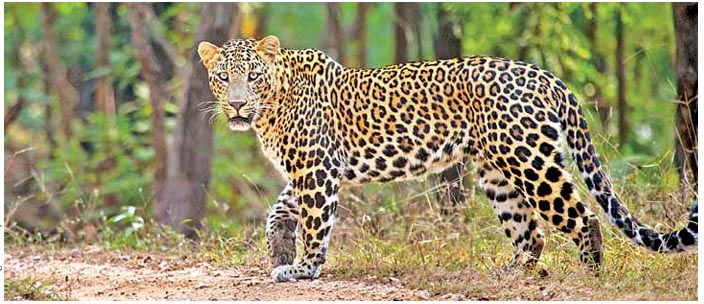
3. OPPORTUNITIES
- The Social Forestry team managed to complete the rescue operation in such tough conditions with limited resources and a small team.
- Restricting leopards in busy and large premises was a typical learning. The method of using nets to restrict the wild animal with noise-making objects to repel him from robable
escaping routes was a typical learning. Method of repelling the leopard back in hiding without harming him or any person was practically useful. - Observation revealed that rescue operations in presence of crowd should be carried out only after ensuring proper security and safety of the team as well as that of the animal. Sometimes when the animal becomes unconscious or is immobilized, the crowd may take advantage to retaliate.
- In such situations, the upper dosage limit of immobilization drugs should be used as a lower dosage will certainly not provide the desired level of sedation in the animal due to the stress caused by the noisy crowd. In this case xylazine, a muscle relaxant, was used @ 1.1 mg per kg body weight and ketamine, a dissociative anaesthetic, was used @ 3 mg per kg body weight.
- Immediate transfer of the leopard to the divisional forest office premises prevented the leopard from causing self-mutilating injuries. Animals injure themselves unintentionally dueto agitation as a result of fear due to too much noise. As the crowd couldn’t enter the closed government office premises, the animal got calm and
stable within an hour in the secluded cage. - The decision of overnight release of the leopard to his natural habitat after three hours of stabilization in the office premises saved time of release as well as prevented human imprint on the animal. The animal was transported as per the recommendation of Singh et al 2018. the collapse of the animal or injuries to the rescue team despite all precautions. Therefore, crowd management needs to be handled properly in such conditions on a priority basis. DISCUSSION SNHC INDIA this SWOT analysis is based on only one
rescue operation, it also has its limitations. But in future, if a detailed SWOT analysis is done based on various other rescue conditions, then it will definitely prove helpful in making the upcoming wildlife rescue operations simpler and easier. - The decision of overnight release of the leopard to his natural habitat after three hours of stabilization in the office premises saved time of release as well as prevented human imprint on the animal. The animal was transported as per the recommendation of Singh et al 2018.
- Releasing the animal at a faraway place about 300 kms from the site of rescue away from human habitation where abundance of prey was available prevented the leopard from stray
ing out again.
4. THREATS
- Inexperienced staff sometimes wrongly approach the animals due to overenthusiasm. This may lead to fatal injuries to the leopard as well as the rescue team members and even the
onlookers. - Limited rescue resources cause unnecessary delay in action and sometimes may result in the escape of animals. Such a situation may also make human-animal conflict even worse
and uncontrollable. - Congestion of traffic restricts movement of rescue teams and transfer of rescued animals. This may result in untoward incidents in an emergency situation. Therefore, a green corridor should be requested from the traffic police for smooth and fast movement of the rescue team.
- It has been observed that sometimes an unruly mob tries to chase the animal and the animal causes fatal injuries to several persons in self- defence. Animals are at times even
beaten to death. There have been incidents of conflict between rescue teams and angry mobs as well. Therefore, proper security arrangements should be in place as soon as a wild animal is spotted or its presence is confirmed. - Too much noise will never allow the darted animal to gain the desired level of sedation and repeated doses of medicines may sometimes result in the collapse of the animal or injuries to the rescue team despite all precautions. Therefore, crowd management needs to be handled properly in such conditions on a priority basis
DISCUSSION
From the SWOT analysis of this rescue operation, on the one hand, the rescue team learned how to rescue a wild animal amidst an extremely noisy crowd, while on the other hand, practical knowledge regarding the drug dosage in such conditions also increased. The team, which has been involved in rescue for years, also gained new knowledge regarding the proper checking of the dart gun barrel before using it for immobilization. Our method of confining the leopard to one place through the net was found to be in accordance with the method of Kumar et al 2023. Sontakke et al 2017 also mentioned the same dose rate of immobilizing drugs which was used by the rescue team for immobilizing the leopard.
However, in such situations, it is clear from this practical experience that if there is a lot of noise from the crowd then, if possible, the maximum drug dosage regimen should
be used in one go after assessing the condition of the animal. In a study by Srivastava et al 2014, it was found that wild animals become extremely irritable especially if there is too much noise and also become aggressive at the sight of humans, especially when kept in cages. Similarly, in this leopard rescue operation, the said leopard was
frightened due to the presence of humans and their noise and at the same time was also adopting a very aggressive form.
CONCLUSION
Wildlife rescue operation in dense urban areas or in the premises of a house or office premises is a very difficult and time-consuming task. It is also a testing time for the rescue team. Such rescue operations always create a new situation and rescuing a wild animal in a new way in these new circumstances is not only a risky task but also teaches something new. This SWOT analysis of wild animal rescue operations in urban conditions will definitely prove to be very useful for future rescue operations. But since this SWOT analysis is based on only one rescue operation, it also has its limitations. But in future, if a detailed SWOT analysis is done based on various other rescue conditions, then it will definitely prove helpful in making the upcoming wildlife rescue operations simpler and easier.
REFERENCES
Jhala YV, Qamar Qureshi, and SP Yadav (2020). Status of leopards in India, 2018. National Tiger Conservation Authority, Government of India, New Delhi, and Wildlife Institute of India, Dehradun. Technical Report TR/2020/16.
Kumar Rajesh and Rakesh Kumar Singh, (2023). A case study on planning, management and execution of leopard rescue in an urban area, Conference on “Wildlife Conservation: Emerging Scenario and Way Forward”, Kanha tiger reserve, Mandla, 27-29 April 2023 Pg-94
Singh RK, Srivastava UC, Nasir M, Bajaj A (2018)- Transportation of wild animals-Practical approach and precautions; ZOO’s PRINT, Volume 33, Number 1, January 2018; Page- 19-22.
Sontakke Sadanand, Umapathy Govindhaswamy, Kumar Devender, Singh DN (2017). A manual on chemical immobilization of wild animals; Central Zoo Authority, New Delhi and LaCONES,
CSIR-CCMB, Hyderabad
Srivastava UC, Singh RK and Gupta S (2014)- Monkey Management in Kanpur Zoological Park, ZOO’s PRINT, Volume XXIX, Number 5 May 2014; page22-25.
Related Posts
Microhabitat charateristics and distribution of ground dwelling scorpions in central india
Microhabitat charateristics and distributionof ground dwelling scorpions in central india By Pragya Pandey, Sanjay…
The Sparrow House Journey: Transformative Impact of PBL from Classroom to Communities
The Sparrow House Journey: Transformative Impact of PBL from Classroom to Communities By Dr. Archana…
Renganathittu – The fascinating Bird Sanctuary
Renganathittu – The fascinating Bird Sanctuary by T. L. John Ranganathittu Bird Sanctuary in Karnataka…
Revival of Sunabeda Wildlife Division – A Case Study
Revival of Sunabeda Wildlife Division – A Case Study By Vishwanath Neelannavar, IFS Sunabeda Wild…

